
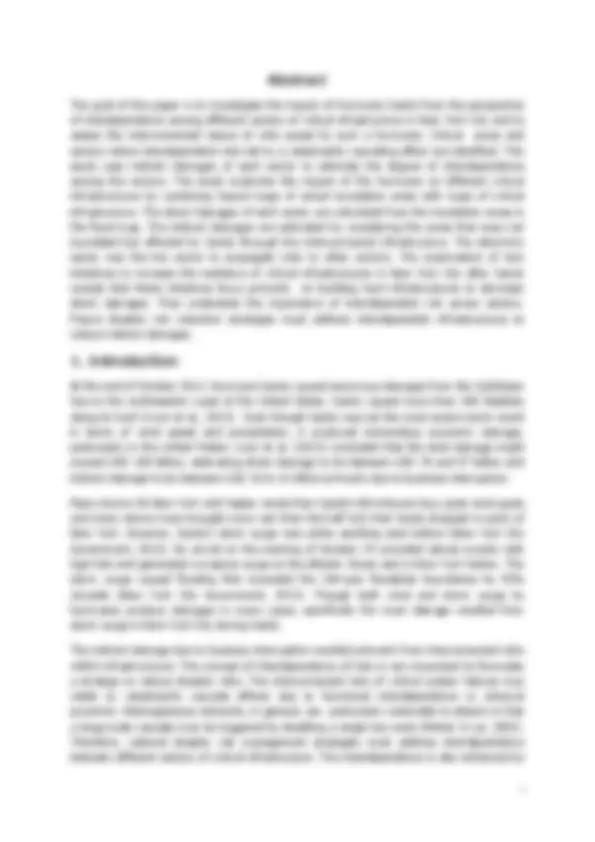
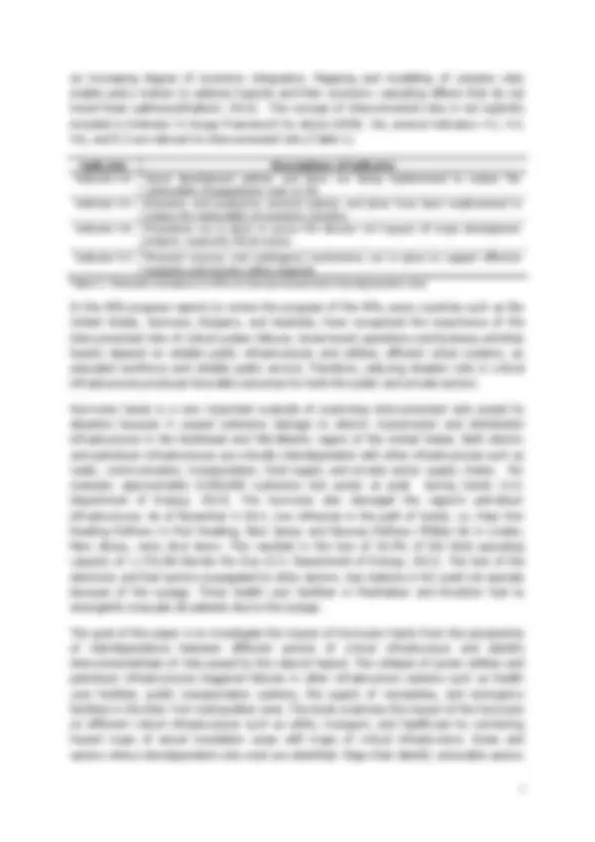
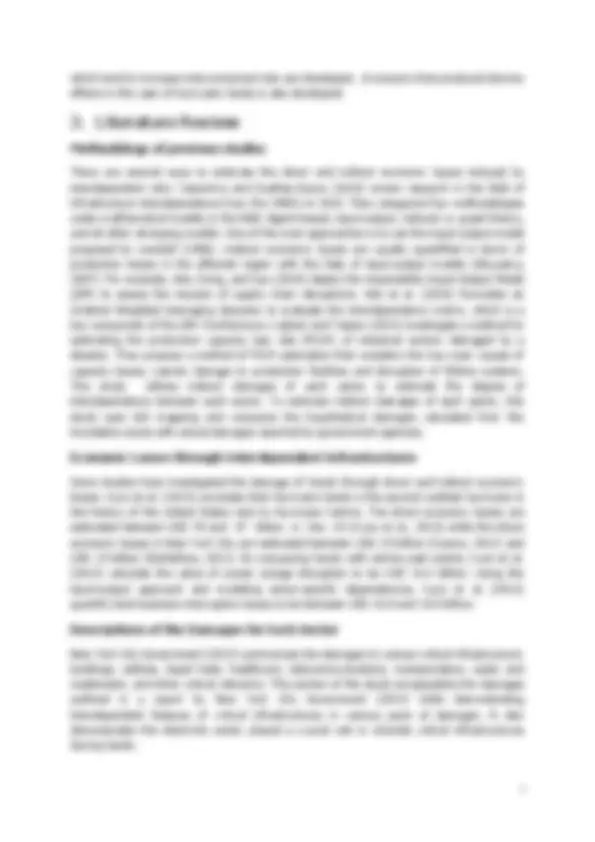
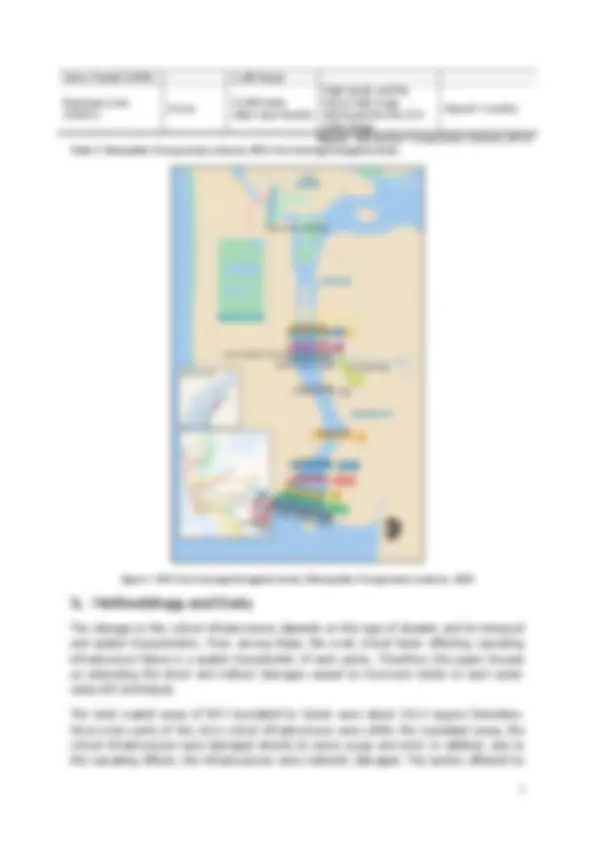
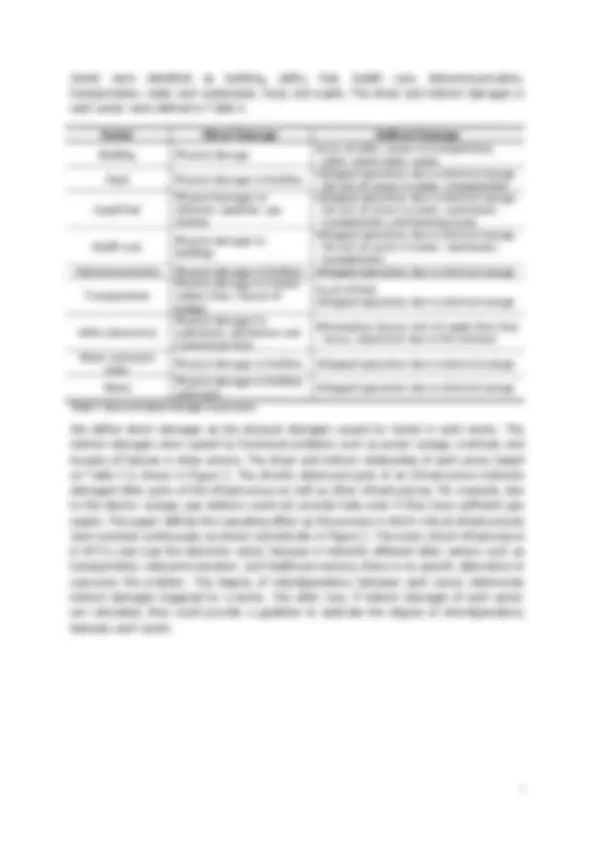
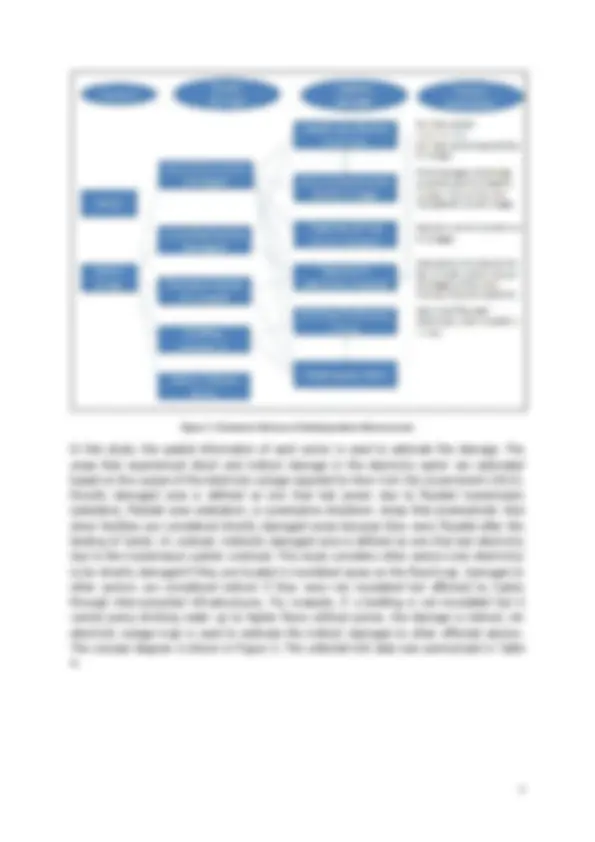
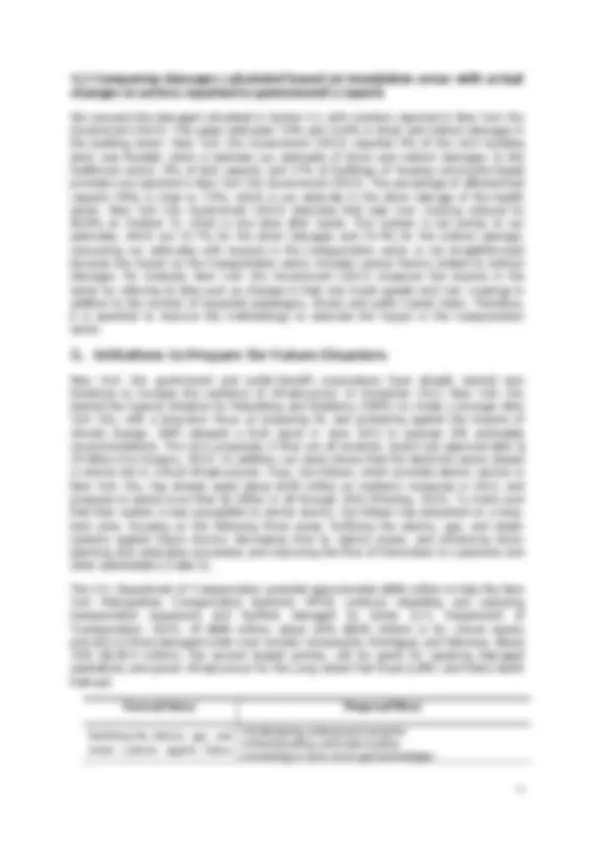
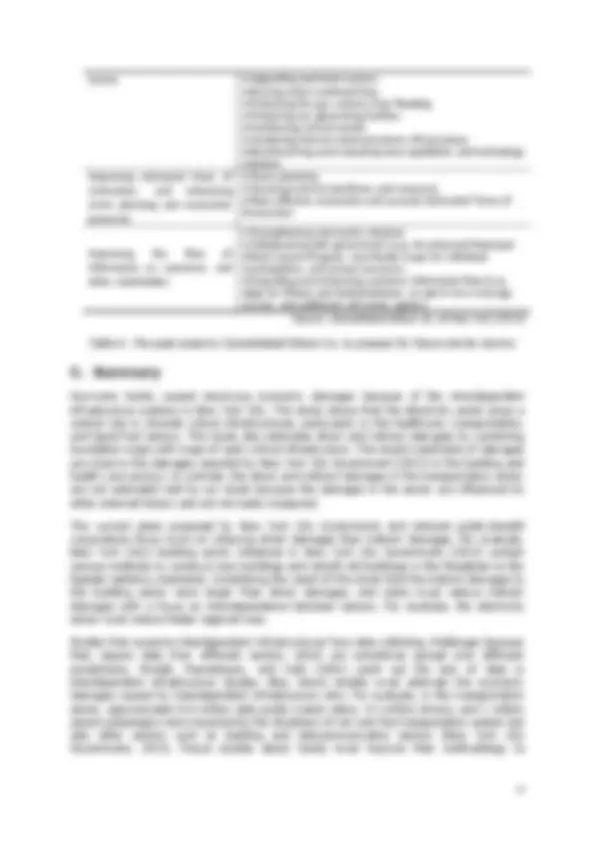
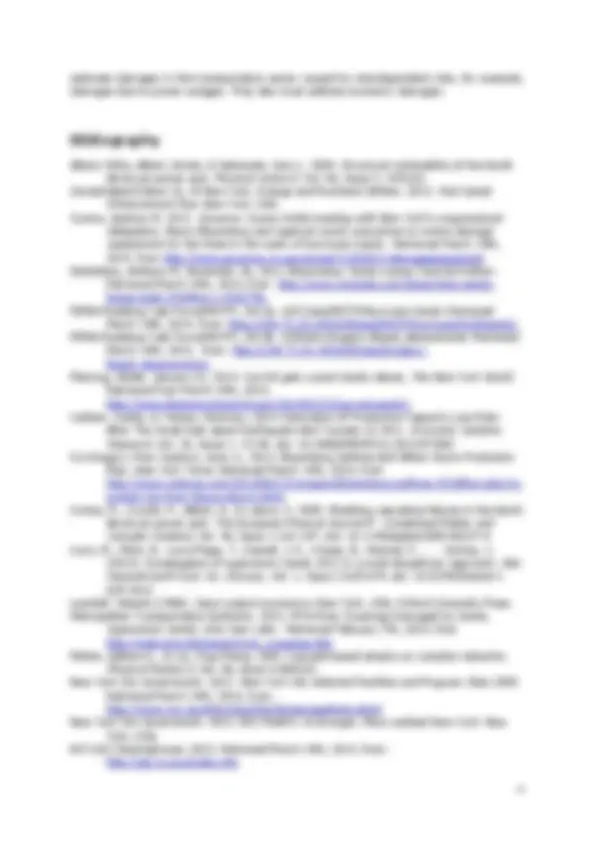


Study with the several resources on Docsity

Earn points by helping other students or get them with a premium plan


Prepare for your exams
Study with the several resources on Docsity

Earn points to download
Earn points by helping other students or get them with a premium plan
Community
Ask the community for help and clear up your study doubts
Discover the best universities in your country according to Docsity users
Free resources
Download our free guides on studying techniques, anxiety management strategies, and thesis advice from Docsity tutors
This paper investigates the impact of Hurricane Sandy on critical infrastructure interdependence in New York City, focusing on sectors such as electricity, transportation, healthcare, and their respective damages. The study combines hazard maps with government reports to estimate indirect damages and highlights the importance of addressing interdependent risks in future disaster management strategies.
What you will learn
Typology: Exercises
1 / 16

This page cannot be seen from the preview
Don't miss anything!










Subtitle (Tahoma 11+Center)
Masahiko Haraguchi Soojun Kim
Columbia Water Center, the Earth Institute, Columbia University
Prepared for the Global Assessment Report on Disaster Risk Reduction 2015
March 14, 2014
an increasing degree of economic integration. Mapping and modelling of complex risks enable policy makers to address hazards and their economic cascading effects that do not travel linear pathways(Radisch, 2013). The concept of interconnected risks is not explicitly included in Indicator in Hyogo Framework for Action (HFA). Yet, several indicators 4.2, 4.3, 4.6, and 5.3 are relevant to interconnected risks (Table 1).
Indicator Descriptions of indicator Indicator 4.2 Social development policies and plans are being implemented to reduce the vulnerability of populations most at risk Indicator 4.3 Economic and productive sectorial policies and plans have been implemented to reduce the vulnerability of economic activities Indicator 4.6 Procedures are in place to assess the disaster risk impacts of major development projects, especially infrastructure Indicator 5.3 Financial reserves and contingency mechanisms are in place to support effective response and recovery when required. Table 1 : Relevant indicators in HFA to Interconnected and interdependent risks
In the HFA progress reports to review the progress of the HFA, some countries such as the United States, Germany, Bulgaria, and Australia, have recognized the importance of the interconnected risks of critical system failures. Government operations and business activities heavily depend on reliable public infrastructures and utilities, efficient urban systems, an educated workforce and reliable public service. Therefore, reducing disaster risks in critical infrastructures produces favorable outcomes for both the public and private sectors.
Hurricane Sandy is a very important example of examining interconnected risks posed by disasters because it caused extensive damage to electric transmission and distribution infrastructures in the Northeast and Mid-Atlantic region of the United States. Both electric and petroleum infrastructures are critically interdependent with other infrastructures such as water, communication, transportation, food supply and private sector supply chains. For example, approximately 8,500,000 customers lost power at peak during Sandy (U.S. Department of Energy, 2013 ). The hurricane also damaged the region’s petroleum infrastructures. As of November 6 2012, two refineries in the path of Sandy, i.e. Hess Port Reading Refinery in Port Reading, New Jersey and Bayway Refinery Phillips 66 in Linden, New Jersey, were shut down. This resulted in the loss of 26.3% of the total operating capacity of 1,170,200 Barrels Per Day (U.S. Department of Energy, 2012). The loss of the electricity and fuel sectors propagated to other sectors. Gas stations in NJ could not operate because of the outage. Three health care facilities in Manhattan and Brooklyn had to emergently evacuate all patients due to the outage.
The goal of this paper is to investigate the impact of Hurricane Sandy from the perspective of interdependence between different sectors of critical infrastructure and identify interconnectedness of risks posed by the natural hazard. The collapse of power utilities and petroleum infrastructures triggered failures in other infrastructure systems such as health care facilities, public transportation systems, the supply of necessities, and emergency facilities in the New York metropolitan area. The study examines the impact of the hurricane on different critical infrastructures such as utility, transport, and healthcare by combining hazard maps of actual inundation areas with maps of critical infrastructure. Areas and sectors where interdependent risks exist are identified. Maps that identify vulnerable sectors
which tend to increase interconnected risks are developed. A scenario that produced domino effects in the case of Hurricane Sandy is also developed.
There are several ways to estimate the direct and indirect economic losses induced by interdependent risks. Satumtira and Dueñas-Osorio (2010) review research in the field of infrastructure interdependence from the 1980’s to 2010. They categorize four methodologies under mathematical models in the field: Agent-based, input-output, network or graph theory, and all other emerging models. One of the main approaches is to use the input-output model proposed by Leontief (1986). Indirect economic losses are usually quantified in terms of production losses in the affected region with the help of input-output models (Okuyama, 2007 ). For example, Wei, Dong, and Sun (2010) deploy the inoperability Input-Output Model (IIM) to assess the impacts of supply chain disruptions. Wei et al. (2010) formulate an Ordered Weighted Averaging Operator to evaluate the interdependency matrix, which is a key component of the IIM. Furthermore, Kajitani and Tatano (2014) investigate a method for estimating the production capacity loss rate (PCLR) of industrial sectors damaged by a disaster. They propose a method of PCLR estimation that considers the two main causes of capacity losses, namely damage to production facilities and disruption of lifeline systems. This study utilizes indirect damages of each sector to estimate the degree of interdependence between each sector. To estimate indirect damages of each sector, this study uses GIS mapping and compares the hypothetical damages calculated from the inundation areas with actual damages reported by government agencies.
Some studies have investigated the damage of Sandy through direct and indirect economic losses. Kunz et al. (2013) concludes that Hurricane Sandy is the second costliest hurricane in the history of the United States next to Hurricane Katrina. The direct economic losses are estimated between USD 78 and 97 billion in the US (Kunz et al., 2013) while the direct economic losses in New York City are estimated between USD 15 billion (Cuomo, 2012) and USD 19 billion (DeStefano, 2012). By comparing Sandy with similar past events, Kunz et al. (2013) calculate the value of power outage disruption to be USD 16.3 billion. Using the input-output approach and modeling sector-specific dependencies, Kunz et al. (2013) quantify total business interruption losses to be between USD 10.8 and 15.5 billion.
New York City Government (2013) summarizes the damages to various critical infrastructure: buildings, utilities, liquid fuels, healthcare, telecommunications, transportation, water and wastewater, and other critical networks. This section of the study encapsulates the damages outlined in a report by New York City Government (2013) while demonstrating interdependent features of critical infrastructures in various parts of damages. It also demonstrates the electricity sector played a crucial role in citywide critical infrastructures during Sandy.
systems. In addition, residential providers also had significant damages. Sixty-one nursing homes and adult care facilities were in areas impacted by power outages and/or flooding. This resulted in reducing bed capacity by 8% citywide. In addition, due to utility outages and damage to building electrical equipment, 26 nursing homes and adult care facilities had to shut down, and another five partially evacuated, decreasing residential capacity by 4, beds citywide. 500 community-based providers (5% of total providers) were located in inundated areas while 1200 providers (12% of total providers) were in areas that experienced power outages only. The impact of failures in the electricity sector on the health sector, one of the examples of interdependent critical infrastructure, was significant.
Sandy also enormously affected every transportation system. Six vehicular tunnels went out of service. All six of the subway tunnels connecting Brooklyn to Manhattan, one tunnel from Queens to Manhattan, and one tunnel from Long Island City to Greenpoint were flooded (Table 2 and Figure 1). In addition, The PATH tunnels under the Hudson River and the railroad tunnels under the East River also were flooded. Because many tunnels were inundated for days, water and corrosion damages to delicate equipment were exacerbated. This shutdown of various transportation systems impacted about 8.6 million daily public transit riders, 4.2 million drivers, and 1 million airport passengers (Table 2).
Name of Crossings (Year of Construction)
Transpor- tation Line
Number of Users Causes of Damage^
Impacted Periods
Harlem River Lift Bridge (1955) N/A^
275,000 daily riders
The facility houses for the bridge were damaged by saltwater.
Closed for trains 3 days Unable to open Bridge for ships 10 weeks 53 Street Tube (1933)
E Line & M Line
275,000 daily riders
500,000 gallons of saltwater Closed 7 days Steinway Tube (1910’s) 7 Line^
200,000 daily riders
1 million gallons of saltwater Closed 6 days
Queens-Midtown Tunnel (1940) N/A
81,000 daily vehicles and 1,100 buses
12 million gallons of saltwater
10 days to fully open
LIRR East River Tunnels (1910)
LIRR+Amtr ak
226,000 daily riders
13.6 million gallons of saltwater
12 days to fully open Greenpoint Tube (1930’s) G Line^
55,000 daily riders
3 million gallons of saltwater Closed 10 days Canarsie Tube (1920’s) L Line^
200,000 daily riders
7 million gallons of saltwater Closed 11 days Rutgers Tube (1930’s) F Line^
130,000 daily riders
1.5 million gallons of saltwater Closed 7 days Cranberry Tube (1930’s)
A Line & C Line
230,000 daily riders
1.5 million gallons of saltwater Closed 7 days
Clark Tube (1910’s) 2 Line & Line^3 145,000 riders^ daily^ .5 million gallons of saltwater Closed 6 days
Montague Tube (1920’s) R Line^
65,000 (pre- storm) daily riders
27 million gallons of saltwater Closed 53 days Joralemon Tube (1908)
4 Line & 5 Line
185,000 daily riders No long-term flooding^ Closed 6 days Brooklyn-Battery Tunnel/ Hugh L. N/A^
47,700 daily vehicles and
60 million gallons of saltwater
21 days to fully open
Carey Tunnel (1950) 3,100 buses
Rockaway Line (1950’s) A Line^
31,000 daily riders (pre-Sandy)
High winds and the heavy tidal surge destroyed the line (3. miles long).
Closed 7 months
Source : Metropolitan Transportation Authority (2013) Table 2 : Metropolitan Transportation Authority (MTA) River Crossings Damaged by Sandy
Figure 1 : MTA River Crossings Damaged by Sandy (Metropolitan Transportation Authority, 2013)
The damage to the critical infrastructures depends on the type of disaster and its temporal and spatial characteristics. From among these, the most critical factor affecting cascading infrastructure failure is a spatial characteristic of each sector. Therefore, this paper focuses on estimating the direct and indirect damages caused by Hurricane Sandy to each sector using GIS techniques.
The total coastal areas of NYC inundated by Sandy were about 216.4 square kilometers. Since many parts of the city’s critical infrastructures were within the inundated areas, the critical infrastructures were damaged directly by storm surge and wind. In addition, due to the cascading effects, the infrastructures were indirectly damaged. The sectors affected by
Figure 2 : Schematic Features of Interdependent Infrastructures
In this study, the spatial information of each sector is used to estimate the damage. The areas that experienced direct and indirect damage in the electricity sector are estimated based on the causes of the electricity outage reported by New York City Government (2013). Directly damaged area is defined as one that lost power due to flooded transmission substation, flooded area substation, or preemptive shutdown. Areas that preemptively shut down facilities are considered directly damaged areas because they were flooded after the landing of Sandy. In contrast, indirectly damaged area is defined as one that lost electricity due to the transmission system overload. This study considers other sectors (not electricity) to be directly damaged if they are located in inundated areas on the flood map. Damages to other sectors are considered indirect if they were not inundated but affected by Sandy through interconnected infrastructures. For example, if a building is not inundated but it cannot pump drinking water up to higher floors without power, the damage is indirect. An electricity outage map is used to estimate the indirect damages to other affected sectors. The concept diagram is shown in Figure 3. The collected GIS data was summarized in Table
Figure 3 : Concept diagram to estimate the direct and indirect damages
GIS Data Data sources Inundated area FEMA Modeling Task Force(MOTF) (2013a) Damaged building FEMA Modeling Task Force(MOTF) (2013b) Electricity outage territory ^ New York City Government (2013) Healthcare location New York City Government (2 012 ) Transportation routes (truck, bus, and subway) NYS GIS Clearinghouse (2013) Table 4 : GIS data sources
This study assumes the infrastructure within inundated areas to be directly damaged. We consider the infrastructure elements which were not flooded but lost power to be indirectly damaged. The direct and indirect damages are estimated using the spatial information of each sector (Figure 3). The estimated damages are summarized in Table 5 and mapped in Figure 4.The area of 173 square kilometers, which was about 12.7% of NYC, was affected by electricity outage or overload, including both the direct (9.9% of NYC) and indirect damages (2.8% of NYC). In the transportation sector, 10.7% of the total transportation mileage was directly damaged while 19.4% was indirectly damaged. In the health care sector, the direct damage was about 7.5% of the total number of facilities while the indirect damage was 2.4% of the total number of health care facilities. 7.0% of the number of buildings was built in the directly damaged areas while 16.8% were built in the indirectly damaged areas. Thus, in these sectors, the direct damage ranged from 7.0 to 10.7% and the indirect damage ranged from 2.4 to 19.4%. The variance of the direct damage in each sector is relatively small, while the variance of the indirect damage is large. This means that the degree to which one sector affects other sectors depends on the degree of interdependence among each sector. As a result, the transportation sector experienced direct damage by the storm surge the most, followed by electricity, health care, and building sectors. The most severely indirectly damaged sector by the electricity outage was transportation, which is followed by building, and health care sectors.
Sectors Direct damage Indirect damage Electricity 9.9% 2.8% Transportation 10.7% 19.4% Health care 7.5% 2.4%
We compare the damaged calculated in Section 4.1 with numbers reported in New York City Government (2013). This paper estimates 7.0% and 16.8% in direct and indirect damages in the building sector. New York City Government (2013) reported 9% of the city’s building stock was flooded, which is between our estimates of direct and indirect damages. In the healthcare sector, 8% of bed capacity and 17% of buildings of housing community-based providers are reported in New York City Government (2013). The percentage of affected bed capacity (8%) is close to 7.5%, which is our estimate in the direct damage of the health sector. New York City Government (2013) describes that east river crossing reduced by 86.8% on October 31, which is two days after Sandy. This number is not similar to our estimates, which are 10.7% for the direct damages and 19.4% for the indirect damage. Comparing our estimates with impacts in the transportation sector is not straightforward because the impact on the transportation sector includes various factors related to indirect damages. For example, New York City Government (2013) measures the impacts in the sector by referring to data such as changes in high way travel speeds and river crossings in addition to the number of impacted passengers, drivers and public transit riders. Therefore, it is essential to improve the methodology to estimate the impact in the transportation sector.
New York City government and public-benefit corporations have already started new initiatives to increase the resilience of infrastructure. In December 2012, New York City started the Special Initiative for Rebuilding and Resiliency (SIRR) to create a stronger New York City, with a long-term focus on preparing for and protecting against the impacts of climate change. SIRR released a final report in June 2013 to propose 250 actionable recommendations. The city’s proposals, if they are all enacted, would cost approximately $ 20 billion (Kia Gregory, 2013). In addition, our study shows that the electricity sector played a central role in critical infrastructures. Thus, Con-Edison, which provides electric service in New York City, has already spent about $105 million on resiliency measures in 2013, and proposes to spend more than $1 billion in all through 2016 (Fleming, 2014). To make sure that their system is less susceptible to similar storms, Con-Edison has embarked on a long- term plan, focusing on the following three areas: fortifying the electric, gas, and steam systems against future storms; decreasing time to restore power, and enhancing storm planning and restoration processes; and improving the flow of information to customers and other stakeholders (Table 6).
The U.S. Department of Transportation awarded approximately $886 million to help the New York Metropolitan Transportation Authority (MTA) continue rebuilding and replacing transportation equipment and facilities damaged by Sandy (U.S. Department of Transportation, 2014). Of $886 million, about 60% ($535 million) is for critical repairs primarily to three damaged under-river tunnels—Greenpoint, Montague, and Steinway. About 16% ($138.9 million), the second largest portion, will be spent for repairing damaged substations and power infrastructure for the Long Island Rail Road (LIRR) and Metro-North Railroad.
Focused Areas (^) Proposed Plans
Fortifying the electric, gas, and steam systems against future
Redesigning underground networks Flood-proofing vulnerable facilities Investing in more smart-grid technologies
storms ^ Upgrading overhead systems Burying select overhead lines Protecting the gas systems from flooding Protecting our generating facilities Reinforcing critical tunnels Hardening internal communications infrastructure Benchmarking and evaluating new capabilities and technology solutions Improving estimated times of restoration, and enhancing storm planning and restoration processes
Storm planning Securing external workforce and resources More effective restoration and accurate Estimated Times of Restoration
Improving the flow of information to customers and other stakeholders
Strengthening community relations Collaborating with government (e.g. An enhanced Municipal (Muni) Liaison Program, new feeder maps for individual municipalities, and annual exercises) Expanding and enhancing customer information flow (e.g. Apps for iPhone and Android phones, an opt-in text message service, and additional call-center agents) Source: Consolidated Edison Co. of New York (2013)
Table 6 : Focused areas by Consolidated Edison Co. to prepare for future similar storms
Hurricane Sandy caused enormous economic damages because of the interdependent infrastructure systems in New York City. This study shows that the electricity sector plays a central role in citywide critical infrastructures, particularly in the healthcare, transportation, and liquid fuel sectors. This study also estimates direct and indirect damages by combining inundation maps with maps of each critical infrastructure. This study’s estimates of damages are close to the damages reported by New York City Government (2013) in the building and health care sectors. In contrast, the direct and indirect damages in the transportation sector are not estimated well by our study because the damages in the sector are influenced by other external factors and are not easily measured.
The current plans proposed by New York City Government and relevant public-benefit corporations focus more on reducing direct damages than indirect damages. For example, New York City’s building sector initiatives in New York City Government (2013) contain various methods to construct new buildings and retrofit old buildings in the floodplain to the highest resiliency standards. Considering the result of this study that the indirect damages to the building sector were larger than direct damages, new plans must reduce indirect damages with a focus on interdependence between sectors. For example, the electricity sector must reduce feeder segment size.
Studies that examine interdependent infrastructures face data collecting challenges because they require data from different sectors, which are sometimes spread over different jurisdictions. Rinaldi, Peerenboom, and Kelly (2001) point out the lack of data in interdependent infrastructure studies. Also, future studies must estimate the economic damages caused by interdependent infrastructure risks. For example, in the transportation sector, approximately 8.6 million daily public transit riders, 4.2 million drivers, and 1 million airport passengers were impacted by the shutdown of not only the transportation system but also other sectors such as building and telecommunication sectors (New York City Government, 2013 ). Future studies about Sandy must improve their methodology to
Okuyama, Yasuhide. 2007. Economic modeling for disaster impact analysis: past, present,
http://www.preventionweb.net/english/professional/networks/private/hfa-thematic- review/documents/concept/GAR15_Concept_Note_RA16.docx. Rinaldi, Steven M, Peerenboom, James P, & Kelly, Terrence K. 2001. Identifying,
Satumtira, Gesara, & Dueñas-Osorio, Leonardo. 2010. Synthesis of modeling and simulation
14th, 2014, from http://www.oe.netl.doe.gov/docs/2012_SitRep19_Sandy_11062012_300PM.pdf.
http://www.oe.netl.doe.gov/docs/Northeast%20Storm%20Comparison_FINAL_ 3c.pdf.
March 14th, 2014, from http://www.dot.gov/briefing-room/us-department- transportation-awards-886-million-new-york-mta-ongoing-hurricane-sandy. Wei, Hairui, Dong, Ming, & Sun, Shuyu. (2010). Inoperability input‐output modeling (IIM) of